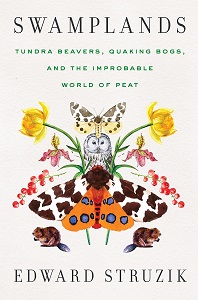
This very well written book, brimming with lively anecdotes and clearly explained information, has a somewhat misleading title. The subtitle finally reveals the main focus: “The Improbable World of Peat.”
Each chapter recounts a visit Struzik took to a different peatland. His descriptions of nature are winsome. His background histories are equally appealing. The chapter on the Great Dismal Swamp in Virginia and North Carolina gives insights on American history, including Pocahontas and John Smith, as well as material on the Underground Railroad.
The themes throughout are: the huge original extent of peatlands in the world; their importance in maintaining water quality and healthy landscapes; the drainage and destruction of much of the peat; and recent efforts to slow further destruction and begin restoration.
“Peat is partially decomposed plant material that builds up over decades, centuries, and millennia in oxygen-starved, waterlogged conditions where decay can’t keep up with growth” (p. 3.) Most peatlands feature mosses, particularly sphagnum mosses, which can cover water and (usually) support the weight of humans and animals. An 1869 Canadian settler called sphagnum fens and bogs “’not to be trusted to walk on’” because “’a moderate sized river loses itself under the deceitful turf’” (p.4). Swamplands have had a bad reputation.
In his chapter on New York City’s Central Park, Struzik moves from Frederick Olmsted’s drainage of wetlands preliminary to creating the park to the long history of drainage in Europe and America. Much of the world’s motivation was to increase cropland. But swamps were, until embarrassingly recently, blamed for their miasma, or bad air, believed to cause illness and death.
Disastrous extinction of species has resulted from all the drainage. Struzik takes us along on a search for a rare wetland moth in the Wagner Fen in Canada. In a detour to discuss other rare moths, he proves his literary chops with this description of a luna moth: “The lime-green gossamer wings are bound by pink-purple seams that give a fairy-like appearance. The tiny Playboy-bunny antennae and the two big Picasso-like eyes, offer, along with sexy-smelling pheromones, an irresistible package” (p. 140).
Many efforts at peat restoration have achieved only moderate or even negative results. One positive story involves beavers. After beavers were successfully reintroduced to degraded peatlands in Scotland, they restored wetlands better than humans could. In the U.S. during World War II, the Interior Department dealt with problem beavers in Idaho by moving them to remote areas to help maintain wetlands. Transportation was difficult. When sending the rodents by mule failed because “it became clear that mules and beavers didn’t get along,” the department dropped the beavers in by parachute. It worked, and the wetlands were improved.
Struzik concludes with an upbeat message on the gains that can be made to return peatlands to their necessary place in the ecosystem and in our cultural history.